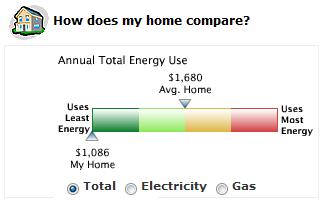Being a resident of south eastern Wisconsin, I have We Energies as my utility provider. I recently signed up for online billing and noticed they have an energy analysis on their website. I though I’d share a little about it and what it showed would be worth while things to pursue to reduce my energy usage.
The analysis is mostly a run through of what appliances you have, how much you use them and other related things. It does take a few minutes to go through how your house is heated, cooled, how many refrigerators you have and all the other info necessary to get an estimation of where the majority of the power usage is in your house and where savings might be had.

Once you’re done running through their questions, you get a nice output like this. This is my analysis and as you can see heating is by and far the biggest energy hog in my house.
The analysis also gives a list of easy things you can do to reduce energy usage. Here are a few things it found that would be good for me to do (in no particular order).
1) Take shorter showers
Implementation Cost: $0
Annual CO2 Savings: 229 lbs
Annual Cost Savings: $12-$21
This is admittedly a weakness of mine. I love a warm shower in the morning. I do use a low flow shower head, and also plan on making the main shower stall an enclosed shower to reduce water usage further.
2) Install heat traps on your water heater
Implementation Cost: $45-$75
Annual CO2 Savings: 163 lbs
Annual Cost Savings: $9-$15
This is one I really hadn’t thought too much about. I’ve heard of heat traps, but apparently its a much larger deal than I had though. This is one of the higher energy losses I’m having according to this analysis. I’d imagine this could be pretty cheap and easily fixed with a few shark bite connectors and some pex line.
3) Wash only full loads of dishes when possible
Implementation Cost: $0
Annual CO2 Savings: 96 lbs
Annual Cost Savings: $7-$11
Who doesn’t do this, honestly?
4) Control air leakage
Implementation Cost: $100-$300
Annual CO2 Savings: 1,119 lbs
Annual Cost Savings: $61-$102
This is one I’ve been working on for a while and will continue getting attention. Its a big deal for me in this 100+ year old house.
5) Insulate your ducts
Implementation Cost: $169-$281
Annual CO2 Savings: 185 lbs
Annual Cost Savings: $10-$17
I should definitely do this. I don’t have a lot of ductwork in unconditioned spaces (the basement), but that just means it’ll be a quick and easier job to take care of it and just get it done.
6) Seal leaks in air ducts
Implementation Cost: $150-$250
Annual CO2 Savings: 608 lbs
Annual Cost Savings: $33-$56
I did this last year and saw a huge difference in the velocity of the air coming out of my vents. Very much worth while and actually nowhere near $150-$250, more like $8 for a roll of aluminum tape.
Anyway, the analysis isn’t as deep as some I’ve seen online, but really doesn’t need to be to identify where the low hanging fruit is. It did surprise me in a few areas that I hadn’t thought were a big deal. For a few minutes of work it can really help you find some simple and cheap things to do to save a few bucks. Unfortunately, if you aren’t a We Energies customer you can’t do their analysis. Thankfully, there are other sources out there. I’d recommend the DOE’s Home Energy Saver. Its actually a much more in depth analysis and can really help find things that need attention or simple things that could reduce your energy consumption.


{ 1 comment }
Thanks for this great tool. I haven’t yet had a chance to browse through everything on this amazing site, so forgive me if you have it covered. We have discovered a great way to heat the house, or a greenhouse or adapt it to heat water, is a simple genius thing call a rocket stove. I had heard about them on my prepper forum but the examples given were not clear how they were so great until someone posted this page- I didn’t know if you allow websites here, so I will just tell you to Google “Paul Wheaton, rich soil, rocket stove mass heater”. And that is the best page I have ever found that clearly illustrates with diagrams and videos how this works, and it shows you in several videos how to construct one. It can be made with cobb, a favorite of many. (locally available clay out of the ground. ) We have no clay here, so we must use brick and fireclay.
Comments on this entry are closed.